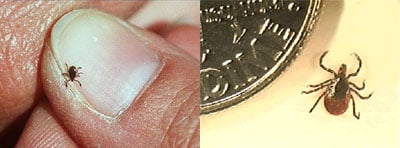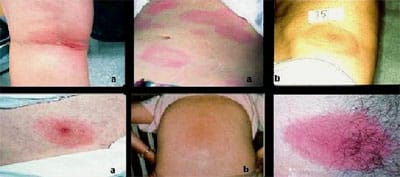First, what is Lyme disease? Lyme disease is an auto-immune disease that is caused by the bite of a deer tick. The tick bites the host mammal it feeds upon, anesthetizes the mammal so it doesn’t feel the bite, cements its mouth piece to the mammal and feeds on the mammal’s blood. The blood mixes in the tick’s stomach with the bacteria that causes Lyme disease (a corkscrew shaped bacteria called borrelia Burgdorferi) and then regurgitates the blood and bacteria into the mammal after a period of many hours of feeding (in a small percentage of cases, the tick’s mouth piece itself is infected and the bacteria is almost instantly passed into the host mammal).

As the Lyme disease bacteria spreads in the mammal, the mammal’s immune system reacts, sometimes creating a classic expanding circular rash (erythema migrans) that has a darkened border with an area of central clearing and a central puncture wound from the bite. However, not all Lyme disease rashes have a “classic” appearance. In fact, a significant number of “Lyme” rashes look different that the “classic” rash. Unfortunately, this has caused some physicians to mistake a “Lyme” rash as a reaction to another type of insect bite, delaying the onset of medical treatment with catastrophic consequences in some cases.

Various examples of Lyme disease rashes
Where can you be bitten by a deer tick? A well-known study was performed by a tick expert in Armonk, New York, a residential community in Westchester County. After dragging a white cloth on the ground over different types of terrain, the expert found: 67% of the ticks in the woods; 22% of the ticks in transitional areas (ecotonal areas) between the woods and lawns; 9% of the ticks in garden shrubbery; and, 2% of the ticks in well-manicured residential lawns. Generally, tick habitats are found in damp and shaded areas such as in the woods under wet leaves or in the brush. This is because ticks need moisture to survive. The vast majority of reported Lyme disease cases have been the result of tick bites that occurred in the northeast and northern central areas of the United States (but cases have been reported in all 50 states.
Sometimes, tick bites happen when rail workers are asked to pick up litter near streams. Other times, tick bites happen when railroad painters and structures department employees are exposed to shrubbery close to structures or in rail yards. Occasionally, tick bites even happen to track and signal personnel in railroad trucks that have been parked up against vegetation along the railroad right-of-way. Ticks do not jump. Generally, you must brush up against a tick for it to be attached. Most often, this happens walking in the brush or by coming into contact with shrubbery.
Under the FELA, interstate Railroad employers are not the outright insurers of the safety of their employees. However, railroads are required to protect employees from reasonably foreseeable risks such as exposure to deer ticks. Railroads located in areas where deer ticks are found are required to educate workers about the risks of Lyme disease, provide deer tick repellant, and have a vegetation control system in place. To that end, Section 213.37 of the Code of Federal Regulations (CFR) actually requires railroad to control “vegetation on railroad property which is on or immediately adjacent to roadbed” to control the vegetation so it does not “interfere with railroad employees performing normal trackside duties.’ Failure to “control” vegetation arguably results in the creation and maintenance of a tick habitat where the risks of a railroad worker being bitten by a deer tick are substantially enhanced. In some federal circuits, violation of a section of the CFR imposed strict liability on the railroad (i.e. the Third Circuit Court of Appeals held that violation of Secretary of Transportation regulations promulgated pursuant to 45 U.S.C. Section 431 is negligence per se under the FELA. Eckert v. Aliquippa & Southern Railroad Co., 828 F.2d 183, 187).
Over the last 25 years, I’ve litigated numerous Lyme disease claims for railroad workers. The first case brought in the U.S. claiming that someone was negligently caused to contract Lyme disease was a case where I represented eight Long Island Railroad Signal Department employees who contracted Lyme disease. In that case, Grano, et al vs. The Long Island Railroad, the railroad was electrifying the east end of its Montauk line in Suffolk County and had laid signal cable in the brush along the right of way until it was ready to have workers dig in the cable. When the cable was eventually dug in, the workers were reportedly covered by insects, including ticks, over a period of time. The Grano case was tried without a jury by federal judge Robert J. Ward in Manhattan who ruled in favor of all four workers in 1993 (the other four claims were resolved before trial).
To obtain damages for contracting Lyme disease on the job, rail employees must be able to show, among other things, that they more likely than not contracted Lyme disease as a result of a tick bite at work and that their employer railroad negligently failed to take appropriate steps to reduce the risk of a tick bite happening at work. In his decision in the Grano case, Judge Ward concluded as a matter of law:
- “The essential element of reasonable foreseeability in FELA actions requires proof of actual or constructive notice to the employer of the defective condition that caused the injury. See Gallick v. Baltimore & O.R.R., 372 U.S. 108, 9 L. Ed. 2d 618, 83 S. Ct. 659 (1963). See also Gallose v. Long Island R.R., 878 F.2d 80, 85 (2d Cir. 1989) (“The catalyst which ignites [the duty to provide a safe workplace] is knowledge, either actual or constructive.”).
- “In this case, the LIRR was negligent due to its failure to provide plaintiffs with a reasonably safe place to work.”
- “The LIRR breached its duty to maintain and inspect work sites so that these areas might be reasonably safe for employees assigned to work there. In the instant case, the railroad knew or should have known by the summer of 1987 of the tick infestations and of the risk of infection by what are commonly called deer ticks which transmit Lyme Disease.”
- “The railroad had a duty to its employees to provide a safe place to work; it breached that duty by failing to provide a safe workplace; and it was foreseeable that the employees would be bitten by ticks and thereafter infected with Lyme Disease.”
- “Plaintiffs established causation by a preponderance of the evidence, although not to a certainty. All four plaintiffs were assigned to work in tick infested areas, for the most part of eastern Long Island, and within weeks or months of working there, manifested symptoms of Lyme Disease. All were subsequently diagnosed as having Lyme Disease. The Lyme Disease contracted by all four plaintiffs was caused by their working in unsafe areas where they were doing their jobs, as they were required to do, in connection with their employment by the defendant LIRR.”
In defense of railroad Lyme disease lawsuits, railroads have hired entomologists (tick experts) to convince trial juries that the tick bite that caused the railroad worker’s Lyme disease happened someplace other than at work. In cases where the evidence shows that the plaintiff was substantially exposed to deer ticks when not at work, it makes it difficult to meet the worker’s burden of proof. In the case of Arthur Jennings v. Metro-North Commuter Railroad, the railroad hired a world-renowned tick expert and chartered a plane to fly over the plaintiff’s residence to show that Jennings lived in close proximity to the woods (At trial, the railroad offered a 5’ X 5’ enlarged black and white overhead photo to show how close the woods were to the Jennings’ home). However, in that case, the worker’s property was completely fenced in and had no shrubbery. The railroad’s expert had to recant his testimony and admitted under my cross examination that it was more likely than not that Jennings contracted Lyme disease as a result of a tick bite that happened at work where he was required to spend days picking up litter along a stream adjacent to a railroad maintenance facility in Brewster, N.Y.
Railroad workers who contract Lyme disease as a result of a tick bite at work can succeed in obtaining monetary damages for their work-related illness. However, to win a Lyme disease lawsuit, it requires a thorough understanding of the science of Lyme disease and, more often than not, the testimony of medical and tick experts who are well versed in the subject of Lyme disease.Ira M. Maurer, Esq. is the founder of The Maurer Law Firm, PLLC, located in Fishkill, New York and has represented injured railroad workers in the Northeast for over 33 years.

